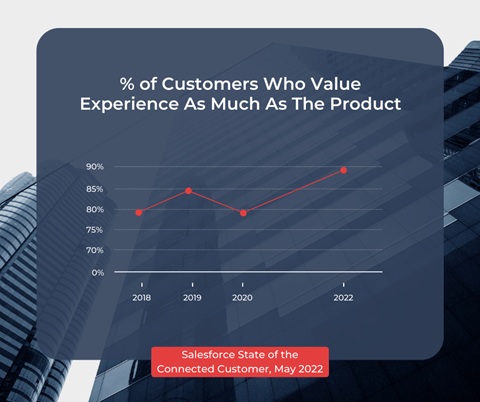According to the fifth edition of the State of the Connected Customer report, the pandemic has upended consumer behavior. Old strategies and tools no longer appeal to or appease new customer demands for speed, convenience, and safety. Products alone are not sufficient to satisfy the new consumer; personalized experience is as essential as the value and quality of products and services.

Figure 1: Percentage of customers who value experience as much as the product
Salesforce conducted a double-blind survey of 13,020 consumers and 3,916 business buyers worldwide between December 8, 2021, through February 1, 2022. Consumers from 29 countries across six continents participated in the survey. Here are three key takeaways from the report on digital transformation:
New Shopping Products and Services in Demand
While the pandemic forced people to have groceries and meals delivered home or picked up directly from stores, many consumers say they will continue to do so in the future. At least eight in ten consumers used contactless payments and mobile ordering between 2020-2022.
What’s remarkable is that the number of contactless payments and mobile ordering is only expected to see a rise. Moreover, the share of customers who said they have used and will use curbside pickup nearly doubled, from 31% in 2020 to 60% in 2022.
Social media, in particular, will be a big player in eCommerce. Six in ten consumers who currently shop via social media say they will do more in the next three years. The idea is straightforward: if your brand is not good at social media, it will soon cease to be a social entity.
Order tracking, subscriptions, shopping via social media, visual experiences, video appointments, and augmented or virtual reality are no longer niche marketing terms. These are some technologies that consumers have already used during the global lockdown. Many expect to continue to use such technologies even more in the next three years.

Omnichannel experience: What’s in and what’s out?
On average, a customer interacts with a business across nine contact points. But changing consumer preferences also means changing brand communication channels and patterns.
Email, for example, has lost its top spot as the channel most preferred by customers, but it remains a favoured choice for more than half of the consumers surveyed by Salesforce partners. The good old phone call has made a dramatic comeback as a primary platform for the entrepreneur and the target consumer to meet and greet. From 54% in 2020, 59% of the surveyed consumers in 2022 rate phones as their most preferred choice.
About four in ten consumers say in-person is their most preferred channel in 2020 and 2022. But a similar number of consumers, 42%, also prefer online chat. About a third use a dedicated mobile app as a mode to communicate with the brand. Messenger apps such as WeChat and Google Hangouts, video chats, text messages, and online portals are other ways a quarter of the consumers prefer to correspond with a business.
The lessons are clear—the customer is not satisfied with just one line of communication. How a brand positions itself and offers a hybrid model of a connected shopping experience will go a long way in winning customers’ hearts.

Figure 2: Expected change in use of technologies/services over the next three years
Digital divide between consumer expectations and business delivery
While the gap between business promises and delivery has been persistent in the past, digital transformation has only widened the gap. Consumers now expect more but feel organizations have not utilized digital transformation capabilities to effective use.
Take service, for example. Good brands promise quick and efficient service if a product does not work as intended. The consumers buy into that pledge and 8 in 10 customers expect to solve complicated cases in a single interaction with a knowledgeable agent.
Yet, more than half (53%) of consumers say most support interactions are fragmented and unsatisfactory because of hold times, handoffs, and ill-equipped agents.
Just when customers expect less work, more is demanded of them. A third of customers say that they had to put in a lot of effort to resolve an issue with a business. About 6 in 10 customers say they had to invest a moderate amount of effort and only a minority, 13%, say they could resolve an issue with relative ease.
Conclusion
Customers know that not all businesses will be able to deliver to their expectations all the time. But they do have higher expectations from companies in specific sectors, such as technology, consumer goods, healthcare, communications, and retail. If you are looking to transform your brand into an industry leader, talk to experts at IMS, Asia’s leading digital transformation agency. IMS provides integrated digital solutions across customer relationship management, digital marketing, and analytics.



